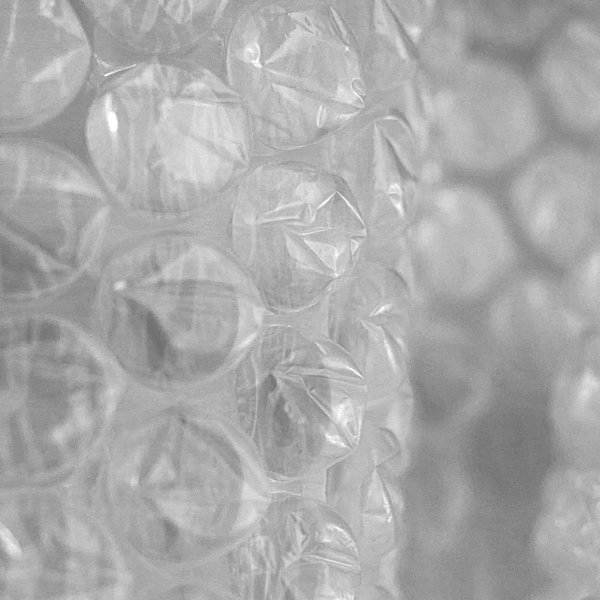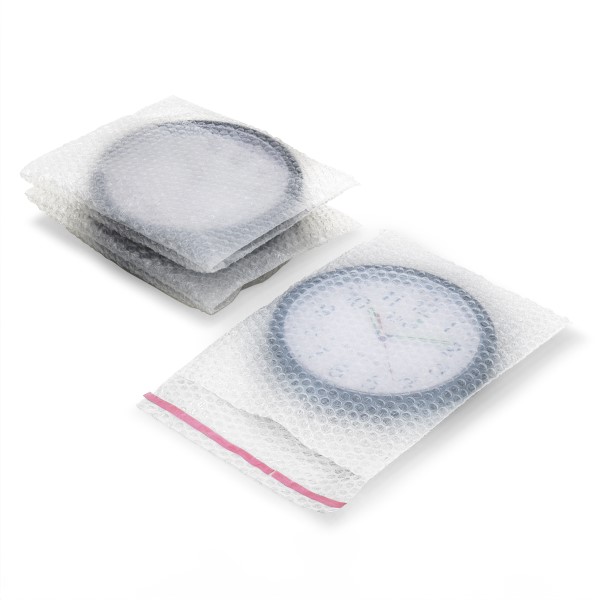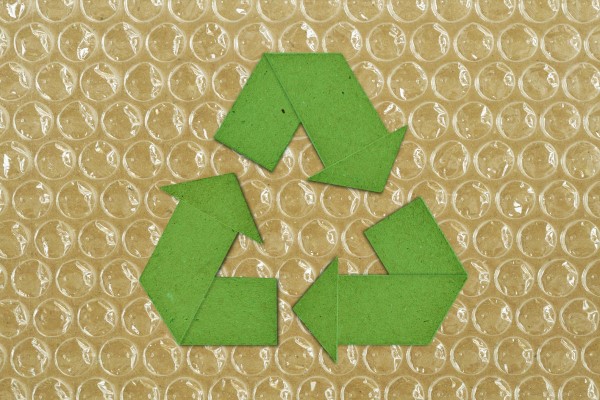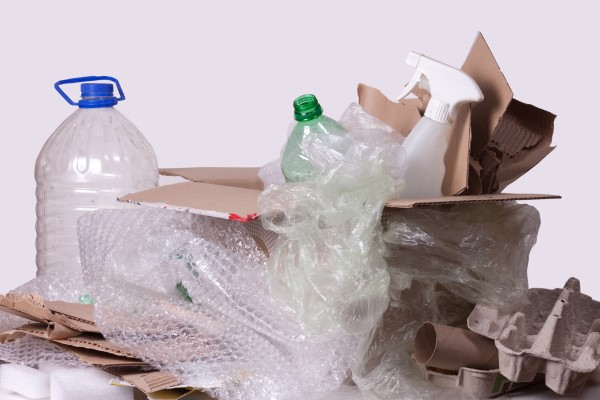Frequently Asked Questions: Bubble Wrap Packaging Products
What is bubble wrap?

Bubble wrap is a type of protective packaging designed to cushion items during shipping, storage, and handling. It’s commonly used by packers to wrap, interleave, or fill empty spaces within boxes. The material acts as a barrier against impact, scratches, and other forms of damage that can occur when moving or transporting goods.
With modern supply chains involving multiple touchpoints, properly wrapping your items with bubble wrap ensures they arrive safely at their destination. Whether you're shipping fragile electronics, delicate glassware, or even furniture, bubble wrap provides an effective and reliable solution for protection.
What is bubble wrap made from?
Most standard bubble wrap is made from Low-Density Polyethylene (LDPE), a flexible and durable plastic material. This composition allows the wrap to be lightweight while still offering strong protective qualities.
For specialized applications, bubble wrap can be manufactured with additional features such as anti-static properties, laminations, or coatings. For example, our furniture protection bubble wrap is designed to safeguard high-gloss surfaces from scratches, vibrations, and static buildup. These enhanced versions are ideal for protecting valuable or sensitive items during transit.
How was it invented?
Bubble wrap was created in the 1950s by two engineers, Alfred Fielding and Marc Chavannes, in New Jersey. Initially, they were experimenting with creating a textured wallpaper, but the product didn’t gain commercial success. However, they soon realized its potential as a protective packaging material and repurposed it for shipping and storage. Since then, bubble wrap has become a trusted and widely used item in the world of packaging.
What are the top uses of bubble wrap?
Bubble wrap is primarily used to protect fragile and breakable items during transport, storage, and moving. Its unique design with sealed air pockets provides excellent cushioning and shock absorption. This makes it perfect for items like glassware, electronics, ceramics, and more.
Common uses include:

How many layers should I use?
The number of layers needed depends on the fragility and weight of the item being packaged. As a general rule, more layers offer better protection. For most items, one layer of bubble wrap is sufficient to prevent scratches, while two or three layers provide extra cushioning for heavier or more delicate items.
If you’re dealing with very fragile or heavy objects, consider using three to four layers of bubble wrap. This ensures maximum shock absorption and minimizes the risk of damage during transit.
Which side of bubble wrap goes inside?
When wrapping an item, the side with the bubbles should face inward, directly touching the object. This provides the best possible cushioning and protects the item from impacts and scratches. The bubbles act as tiny air pockets that absorb shocks and keep the item secure.
The smooth side should be on the outside, making it easier to tape and handle the package during the packing process. This also helps maintain a neat and professional appearance.
Is bubble wrap reusable?
Yes, bubble wrap can be reused multiple times if it remains in good condition and the bubbles are intact. Many people reuse it for various purposes, such as gardening, insulation, or even moving. It’s a cost-effective and practical option for those looking to reduce waste and extend the life of their packaging materials.
Is bubble wrap recyclable/eco-friendly?

Bubble wrap is indeed recyclable, but it’s not typically accepted in standard household recycling bins due to its thin film structure. Instead, it should be taken to designated recycling points or collection bins found in supermarkets and shopping centers. Some brands, like Kite, offer bubble wrap that is 100% recyclable and contains recycled materials.
Our anti-static bubble wrap is also easy to recycle because it’s made from a single type of PE film. However, recycling options may vary depending on your location, so it’s always a good idea to check with your local council before disposing of it.
Where can I recycle bubble wrap in the UK?
In the UK, bubble wrap is not suitable for kerbside recycling because it can clog machines. Like plastic bags, it needs to be taken to specialist recycling facilities. Many supermarkets and shopping centers have dedicated collection points for this type of material. You can often find them near the entrance or in the customer service area.
What is the difference between small and large bubbles?
The size of the bubbles in bubble wrap determines the level of protection they offer. Small bubbles, usually around 10mm or 1/4 inch in diameter, provide compact cushioning and are best suited for smaller, more delicate items. They are ideal for wrapping things like electronics, glass bottles, or small decorations.
Large bubbles, which are typically 20mm or 1/2 inch in diameter, offer greater shock absorption and are better for heavier or bulkier items. These are commonly used when packing furniture, appliances, or other large objects that require more padding during transport.
What's great about bubble wrap?
Bubble wrap is a versatile and widely used packaging material that offers several advantages:
What are the downsides of using bubble packaging?

While bubble wrap is highly effective, it does have some drawbacks:
Where to buy bubble wrap?
We offer a wide range of high-quality bubble wrap products tailored to meet different needs. Our durable and reliable solutions ensure that your items are well-protected during transit. Choosing Kite means enjoying competitive pricing, bulk discounts, and fast delivery services.
Additionally, we are committed to sustainability, offering bubble wrap with up to 30% recycled content. This makes it an eco-friendly choice for businesses and individuals who care about reducing their environmental impact.
With eight locations across the UK, we make it easy to access the materials you need. Whether you're a small business owner or a homeowner, you can rely on us to deliver the right packaging solutions straight to your doorstep.
Looking for alternatives to traditional bubble wrap? Check out our guide on eco-friendly packaging options, including paper-based substitutes and biodegradable materials. We have a variety of sustainable choices to suit your specific requirements.
Bubble wrap guide
To learn more about the features, suitability, and recyclability of our bubble wrap rolls, explore our detailed guide. It covers everything you need to know to make informed decisions about your packaging needs.
{ "@context": "https://schema.org", "@type": "FAQPage", "mainEntity": [ { "@type": "Question", "name": "What is bubble wrap?", "acceptedAnswer": { "@type": "Answer", "text": " Bubble wrap is a form of protective packaging that cushions your items within a box. Packers use it to wrap, interleave or fill voids. As a packing material provides a great defence against impact damage, scratches and scrapes during shipping and handling.\n\nAs packages encounter many touchpoints in supply chains, wrapping your goods prepares them for safe shipping and handling." } }, { "@type": "Question", "name": "What is bubble wrap made from?", "acceptedAnswer": { "@type": "Answer", "text": " Standard varieties are made from Low Density Polyethylene film (LDPE).\n\nWhen made with other materials, bubble packaging is perfect for specialist needs and products. For example, our specialist furniture protection combines high-quality bubbles and lamination with special protective coatings. Because of this, it keeps your high polished furniture safe from knocks, scuffs, scrapes and vibrations. It stops the build-up of static electricity as it is also anti-static. " } }, { "@type": "Question", "name": "How was bubble wrap invented?", "acceptedAnswer": { "@type": "Answer", "text": " Bubble wrap was invented in New Jersey by two engineers, Alfred Fielding and Marc Chavannes. They were trying to create a new type of textured wallpaper which ended up being commercially unsuccessful. Later, they repurposed it as packaging, and it has since become a material we all trust." } }, { "@type": "Question", "name": "What are the top uses of bubble wrap?", "acceptedAnswer": { "@type": "Answer", "text": " Bubble wrap products mainly protect breakable and fragile items during storage, moving and shipping. The wrap has pockets of sealed air which look like bubbles, giving the material its name. These cushion and protect delicate items like glassware, electronics and ceramics.\n\nCommon uses:Mini Dice,Mini Gathering Dice Set,Role Playing Gaming Mini Dice,Polyhedral Rpg Mini Dice Set
NINGBO BESCON GAMES AND APPLIANCES CO., LTD , https://www.bescondice.com